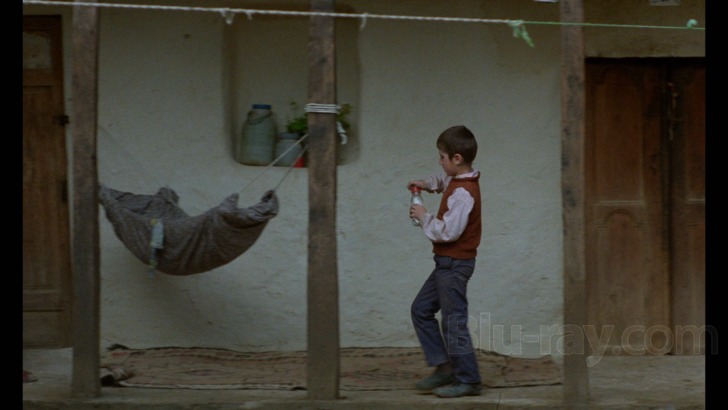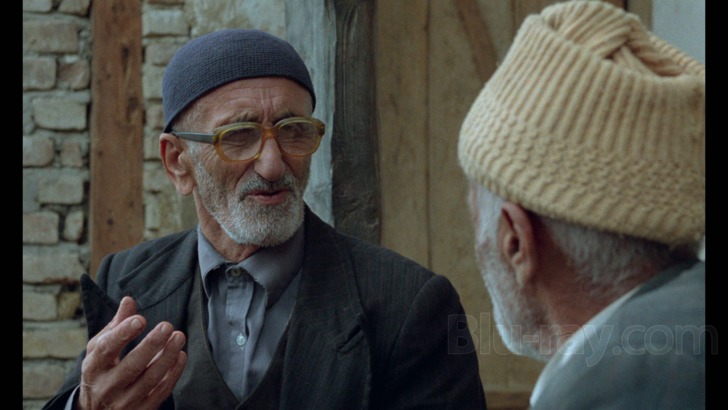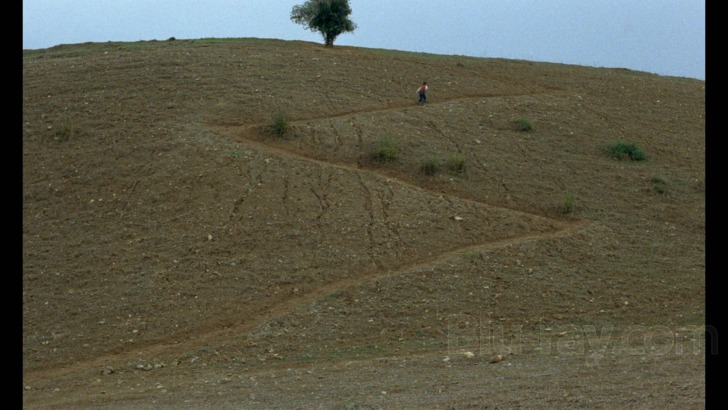Where Is the Friend's House? Blu-ray Movie
HomeWhere Is the Friend's House? Blu-ray Movie 
خانه دوست کجاست / Khane-ye doust kodjast?Criterion | 1987 | 83 min | Not rated | No Release Date

Price
Movie rating
7.6 | / 10 |
Blu-ray rating
| Users | 0.0 | |
| Reviewer | 4.5 | |
| Overall | 4.5 |
Overview
Where Is the Friend's House? (1987)
An Iranian schoolboy scours a neighboring village for a classmate's home to return an important notebook.
Director: Abbas Kiarostami| Foreign | Uncertain |
| Drama | Uncertain |
Specifications
Video
Video codec: MPEG-4 AVC
Video resolution: 1080p
Aspect ratio: 1.66:1
Original aspect ratio: 1.66:1
Audio
Persian: LPCM Mono
Subtitles
English
Discs
Blu-ray Disc
Single disc (1 BD)
Playback
Region A (locked)
Review
Rating summary
| Movie | 4.0 | |
| Video | 4.5 | |
| Audio | 3.5 | |
| Extras | 5.0 | |
| Overall | 4.5 |
Where Is the Friend's House? Blu-ray Movie Review
A bold voice in world cinema transports audiences to Koker
Reviewed by Neil Lumbard September 9, 2019Transporting viewers directly into the world and location inhabited by the people of Koker, Where Is the Friends House? explores the ordinary life lived by the young Ahmed (Babek Ahmed Poor) and his unique journey taken. Having taken the papers of one of his classmates on accident, Ahmed has to try to return the schoolwork to his friend and the film focuses on his attempt to bring the schoolwork back. Traveling across the barren landscape of Koker, the audience witnesses his expedition to save his close friend from expulsion from school.
Unlike a true narrative-driven feature, the film is predominately focused on being character-driven with a unique stylistic approach. The film has almost no dialogue and often feels like it's a documentary film rather than a narrative effort: Ahmed behaves like an ordinary child would and the performance feels so natural as to not feel like an example of acting at all. This was how Kiarostami viewed working with a young cast of actors as well: one had to recognize that children would often revert to being themselves that it's a unique challenge working with young actors.

A compelling drama which illustrates youth in Koker
Produced by Ali Reza Zarrin (Close-Up, The Key), Where Is the Friends House? is an invigorating experience. The style of the filmmaking is so distinctive that it feels remarkably unique in the landscape of cinema. The beautiful cinematography by Farhad Saba (Homework, Through the Olive Trees) easily draws one into the world of the filmmaking and manages to feel artistically compelling throughout. The evocative score composed by Amine Allah Hessine accompanies the imagery in a intelligent and empathetic way. The costumes designed by Hassan Zahidi (And Life Goes On) feel authentic and helps the filmmaking feel more realistic.
There is something about Where Is the Friend's House? that feels uniquely compelling. Some of it is the performance by Babek Ahmed Poor and how authentic it feels in the context of the story. On another level, the feature is a prime showcase for the talents of its filmmaker: Abbas Kiarostami (Taste of Cherry, Certified Copy). The artistry is high and there are no throw-away shots. The film feels as if it is carefully constructed from start to end (which is the surest sign of a great director). There is magic to be found in movies when they can speak to audiences about something so universal as the experiences of youth while taking viewers on a journey across cultures and borders. Where Is the Friends House? pulled me in and left me mesmerized.
Where Is the Friend's House? Blu-ray Movie, Video Quality 

The Criterion Collection presents Where Is the Friends House? with a 1080p MPEG-4 AVC encoded high definition presentation in the original 1.66:1 widescreen aspect ratio. This is a brand new 2K restoration. What a wonderful joy it is to see such labor of love for film preservation. This is an altogether stunning presentation of the film which has clear detail throughout. A naturally filmic presentation with excellent color reproduction and detail that helps to bring the quiet moments of the film to life.
From Criterion: "Where Is the Friend's House? and And Life Goes On were created in 2K resolution on an ARRISCAN film scanner from the 35 mm original camera negatives at L'Image Retrouvee in Paris."
Where Is the Friend's House? Blu-ray Movie, Audio Quality 

Where Is the Friends House? is presented in the original Persian language with English subtitles. This is a lossless uncompressed PCM mono soundtrack. The film featured sound recording by Jahangir Mirshekari. The Criterion audio restoration came from the 35 mm soundtrack negatives. As noted in the booklet: "Clicks, thumps, hiss, hum, and crackle were manually removed using Pro Tools HD and iZotope RX." It's clear that a lot of effort was placed in preserving and restoring the audio.
Unfortunately, the film itself simply lacks a very compelling audio track from a sonic perspective. It sounds altogether harsh and uninviting. Criterion tends to be the best in the industry when it comes to preservation and I feel the harshness of the track is clearly source-related (and not a fault of the label). It's a listenable audio track (and to Criterion's credit they even used 24 bit depth for the encode) but the recording is never crystal clear at any point in the presentation. The audio simply sounds thin and it can seem a little underwhelming.
Where Is the Friend's House? Blu-ray Movie, Special Features and Extras 

It's worth noting that the booklet included with the trilogy release is housed inside of the packaging for Where Is the Friends House? The contents contain information on the restoration from Criterion and a essay about the films by author Cheshire. The 32 page booklet includes photographs and production notes.
On disc supplements on the release include the following:
Homework (HD, 1 Hr. 18 min.) is a 1989 documentary feature from director Kiarostami. The feature was produced by interviewing the students attending the Martyr Masumi Grade School as located in Iran.
This is one of the best supplemental feature inclusions I have ever seen on any release from Criterion. For starters, the film is quite absorbing and engaging. It felt like the type of documentary which could have easily have been included in the collection with its own numeric spine number and place (outside of "supplemental" relegation).
This is an incredibly powerful and haunting documentary. The entire film revolves around the director asking a group of young children about their thoughts on homework: do they enjoy it, how do they approach it, and what do their parents do when they excel or under-perform? Do they prefer doing homework to watching cartoons? The film is haunting. As the film progresses, more and more children discuss how their parents beat and abuse them if they don't do their homework or if their grades are less than stellar. None of the children even have the courage to say they prefer watching cartoons to doing their homework, either. (Perhaps afraid of their punishments by their parents.)
Kiarostami also shows how parents feel they do not need to be involved in their children's homework (showing a survey found they should bear no responsibility on their children's homework or helping them, that it should all fall on teachers). The filmmaking is empathetic and eye-opening while also being clinical and subjective to the material.
Please note that the audio track included on the documentary feature is presented in mono Dolby Digital at 192kbps. This is not a showy audio track with the same degree of clarity as a lossless track (such as what is found on the main feature film). However, given that this is a documentary production, I found the audio quite satisfactory for the film presentation. I had no major complaints and don't think viewers will either.
Abbas Kiarostami (HD, 1 Hr. 8 min.) is an in-depth discussion between the filmmaker behind the Koker Trilogy and film programmer Peter Scarlet following a presentation of Where Is The Friends House? The interview was conducted on stage with translation from Massoumeh Lahidji. Recorded in 2015, the interview is an enlightening interview in which questions are fielded from the audience about the filmmaker and his approach to storytelling. There are both fun and serious questions asked. It felt as though Kiarostami put a lot of thought into his answers. Thoroughly engaging from beginning to end, it is the kind of discussion that helps deepen ones appreciation of the film.
Where Is the Friend's House? Blu-ray Movie, Overall Score and Recommendation 

There is much to appreciate about Where Is the Friends House? As the first feature in Kiarostami's Koker Trilogy, it sets the tone and style of all three films beautifully. The filmmaking style is unique and inspired. The film seems to drift between feeling like a documentary (a true tribute to the talent of its director) and narrative-based storytelling seamlessly. There are distinctive images in the film which feel as if they are individual masterpieces of art which one could frame and hang on a wall. That takes talent and drive that can only be delivered by an auteur director like Kiarostami. This is awe-inspiring cinema.
Even better than the main feature is the exceptional documentary Homework. Included on the disc as a supplemental feature, Homework is so eye-opening and compelling I was surprised Criterion did not deem it as a title to receive its own slot in the collection. I was just as blown away by this documentary as the main film included on this release. A must-see for all Kiarostami fans and a supplemental feature which greatly enhanced my appreciation of the collection.
Similar titles
Similar titles you might also like
(Still not reliable for this title)

And Life Goes On
زندگی و دیگر هیچ / Zendegi va digar hich / Life, and Nothing More...
1992

Through the Olive Trees
زیر درختان زیتون / Zire darakhatan zeyton
1994

Wild Strawberries
Smultronstället
1957

Taste of Cherry
طعم گيلاس / Ta'm e guilass
1997

Cemetery of Splendor
2015

The Hunt
Jagten
2012

Port of Call
Hamnstad
1948

Kings of the Road
Im Lauf der Zeit
1976

Alice in the Cities
Alice in den Städten
1974

The Silence
Tystnaden
1963

Au revoir les enfants
1987

Yi Yi
一一
2000

Beyond the Hills
După dealuri
2012

Fanny and Alexander
Fanny och Alexander / Television and Theatrical Versions
1982

Taxi
2015

Pain and Glory
Dolor y gloria
2019

Like Father, Like Son
2013

Julieta
2016

The Rocket
2013

The Traveler
مسافر | Remastered
1974